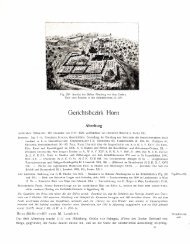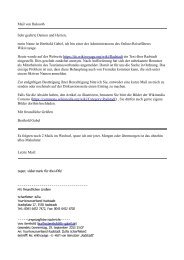Serial Programming - upload.wikimedia....
Serial Programming - upload.wikimedia....
Serial Programming - upload.wikimedia....
Create successful ePaper yourself
Turn your PDF publications into a flip-book with our unique Google optimized e-Paper software.
Wiring Pins Explained<br />
One thing to keep in mind when discussing these pins and their meaning, is that they are<br />
very closely tied together with modems and modem protocols.<br />
Whenever interconnecting any serial ports it will be well to note that whatever the case, it<br />
should always follow that only one should ever be tied to one or more <br />
generally speaking. Further, be it noted that signal names at the COMx end will generally<br />
be opposite of the - -sense- at the modem end of things, even though carrying<br />
the same mnemonic names.<br />
Often you don't have a modem attached in the loop, but you still treat the equipment as if<br />
it were a modem on a theoretical level. At least such that you minimally have an <br />
going to every in some manner, with no two in conflict or without any 'floating'<br />
tied to no at all.<br />
The following are more formal explanations regarding each signal function in the general<br />
sense of its use:<br />
2.4.1 DCD (Data Carrier Detect)<br />
This is a signal to indicate from the communications equipment (DCE) that the phone<br />
line is still "connected" and receiving a carrier signal from the modem at the other end.<br />
Presumably well-written software or serial equipment could detect from this logic state when<br />
the telephone has been "hung up" on the other end. Null-modems often tie DCD to DTR at<br />
each end since there is no carrier signal involved.<br />
2.4.2 RX (Receive Data)<br />
Input to receive the data.<br />
2.4.3 TX (Transmit Data)<br />
The reverse of RX, this is where the terminal equipment (DTE) is transmitting serial<br />
data, using the same format and protocol that the receiver is expecting. More on the<br />
exact protocol further below. Like RX, think along the lines of "Terminal Transmit" when<br />
designing equipment that will be using this pin.<br />
2.4.4 DTR (Data Terminal Ready)<br />
Basically a signal from the DTE that says "Hello!, I'm ready if you are". This is a general<br />
indicator to the DCE that the terminal is ready to start sending and receiving data. If there<br />
is some initialization that needs to happen in the communications equipment, this is a way<br />
for the terminal equipment to "boot" the receiving equipment. In an null modem setup this<br />
signal is often connected to DCD, so the device signals itself that an (imaginary) carrier has<br />
been detected, indication that the transmission line is up.<br />
17
















